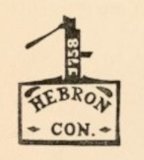
The Hebron Historical Society
Hebron, Connecticut
Enjoy Hebron - It's Here To Stay ™


Enjoy Hebron - It's Here To Stay ™

“At the time [I enlisted] I was working at Electric Boat in Groton as a ship fitters helper. When I informed the boss, I was told I could get a deferment because it was a defense-related job. But at that time, a civilian at my age was looked down upon if he wasn’t in the services. Besides, all my friends were going in, so I went too.”
Thus begins the memories of Leonard Carey Porter, one of Clarence and Alma Porter’s four sons, all of whom enlisted in the service of the United States during World War II. (The other Porter brothers were David, who served in the Pacific theatre with the Navy; Earl, a Marine who served in the Marshall Islands; and Howard, who served with the Army Air Corps in England.)
There are actually two versions of Lenny’s story. An earlier, 35-page typed version of the document was recently donated to the Hebron Historical Society by Donald Robinson’s family. Lenny notes in this version that he had recorded his memories at the request of his daughter-in-law, Nancy Porter, and that it had been written 38 years after his discharge, which would have been approximately 1984. The second version, a 71-page, handwritten document, is dated April 5, 2004, and was recently loaned to the Historical Society by the Porter family. While similar, both versions offer unique details.
Lenny’s recollections of his basic training in Texas are sure to bring laughter. “We didn’t have a chow car on the train, so twice a day it would stop in some town and we would be fed. This must have been prearranged because they were ready for us. They all looked like lunch wagons and all loaded with cockroaches, some big enough to be waiters.” Lenny also recounts the servicemen forming tight circles after calisthenics, trying to catch jackrabbits. “We would grab a leg, then they would start kicking and it seemed they could kick harder than a jackass. I never did see one caught. What fun.”
Lenny readily volunteered for flight duty, and was moved to Tucson, Arizona for B-24 flight training. It was in Tucson that approximately 30 flight crews were formed, and after listing each individual man in his particular crew, Lenny, the Flight Engineer, notes: “These are the guys I would go into combat with.”
Training day and night, the crews were sometimes so exhausted they would simply hang their flight gear on the ends of their bunk beds, ready for the next flying session. “During that time, we started to lose some or crews. That’s always a morale buster,” Lenny wrote. From Tucson, the crews were sent to Salinas, California for Phase Two training. Here, more crews were lost and even Lenny’s crew suffered a close call, almost crashing into the Cascade Mountains. “The Good Lord was with us,” he wrote.
But accidents continued to happen. “As we finished up our 2nd phase of training, we had lost almost half of our crews. This had everyone on edge and it was tough to cope with.” The Army decided to send the crews to Blythe, California for two extra months of training. “In my opinion that extra training time had a lot to do with our survival in combat.” But even in Blythe, another crew was lost. Lenny witnessed the horrific accident. “They were really struggling to stay in the air. Suddenly, the wing dropped down and the nose too and they went right into the ground. There was lots of dust, then a huge ball of fire as the fuel tanks ruptured and caught fire. No survivors.”
In such a stressful environment, Lenny was especially happy to learn that his old friend, Joe Kowalski, was stationed in Yuma, Arizona. Lenny and Joe had been classmates at Hebron Center School, and Lenny wanted to see him. He obtained a pass and set out on foot for Yuma, battling rattlesnakes and sleeping on the ground until he finally was able to hitch a ride with an Army convoy. Lenny and Joe visited for a couple of hours; Lenny then returned to Blythe, hitching a ride with the same convoy.
It was time to go to war. Lenny’s crew named their plane “Slow Time Sally.” Leaving from Bangor, Maine, “Sally” flew over key stop points until they reached their ultimate destination of Benghazi, Libya. “In this area the fighting went back and forth between the Germans and Italians and the British. The whole area was just one big junk yard…The ground was just littered with burned out tanks, shot up vehicles of all sorts. What a mess of iron.”
Soon, Lenny’s squadron was moved to Tunisia: “Now, it was time for real combat.” Ordered to strike a bridge in East Italy, vital to the German supply line, the day began at 3:00 a.m., a quick breakfast, a briefing on how much opposition to expect, “and, most importantly, a prayer from our chaplain putting the Good Lord on board with us.” The planes, powered by Pratt & Whitney engines, took off four abreast. P-38 fighter escorts soon surrounded the bulkier B-24’s. The bridge was easily destroyed. “I will say now that of all 50 missions I flew, that first one was by far the easiest. No enemy fighters. No anti-aircraft fire. No bad weather. No nothing. But that would be the last one like that.”
From this point forward, Lenny Porter experienced war first hand, non-stop. He discovered a man’s leg, blown off at the hip, in the sand of a nearby beach. He detonated a live bomb on board his ship that hadn’t released. He saw his friend and fellow gunner, Art “Brownie” Brown, killed. He faced a target in Weiner Neustadt, Austria, surrounded by 400 German anti-aircraft batteries.
On November 2, 1943, the crew moved to Brindisi, Italy, where they were ordered to hit Weiner Neustadt again. “That news got me shaking in my shoes but you couldn’t say, well I don’t think I will fly today. We all knew what was coming.” German MiG 109’s were soon right above Lenny’s squadron. “They would come at full throttle and dive right through the formation. It happens so fast…” Yet the mission was successful this time. “That place was just one big heap of junk.”Shortly after Christmas, Lenny’s plane suffered severe damage from German flak. The Number Four engine caught fire; “then the No. 3 engine caught fire. Now we are in deep trouble.” Chaos broke out on the plane; Lenny had a gunner hold on to him so he wouldn’t fall out of the plane as he did repairs. He pumped fuel from one cell to another, trying to stabilize the plane, then starting throwing out anything of weight. Eventually, an emergency landing was made in friendly territory, but “Slow Time Sally” was so shot up, it never saw action again. Lenny, for his part, was awarded the Distinguished Flying Cross, “awarded to any officer or enlisted man of the Armed Forces of the United States who shall have distinguished himself in actual combat in support of operations by heroism or extraordinary achievement while participating in an aerial flight.”
Following many more heart-stopping engagements, including one over Munich, Lenny finally came home in 1944. He was happy to be back in Hebron, although he still faced the realities of America in wartime. “Since the war was still on, the Rationing Board was operating. It was run by Mrs. Getchell who lives on the corner of 66 and 316. I had my car and I was always after gas stamps. One day when I went to see her, she said to me, ‘Leonard, don’t you know there is a war going on?’ As if I didn’t know about the war.”
Less than a month after finishing his memoirs, just after his 87th birthday, Leonard Carey Porter passed away on May 1, 2004. What a gift he has left us by documenting his memories.